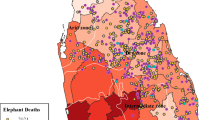Abstract
Mapping of land use/land cover (LU/LC) is an important activity of land management and monitoring, but mining activity has an effect on land, environment and local society. The analysis of land changes map is prepared using high resolution imagery and provide mining information. The rate of deforestation and forest fragmentation has also decreased due to mining activity. This has resulted in over exploitation of natural resources due to mining activities like deforestation, cultivation of marginal lands, mining and industrialization in meeting the increasing demand for food, fuel and fiber. Geo-spatial technology has led to the hosts of undesirable effects on the ecosystem. The risk buffer zone is manipulated based on environmental concern and field verification. Mining operations involve in mineral extraction from the earth’s crust, tends to make a notable impact on the environment, landscape and also biological communities of the earth in the mining area. LU/LC change detection and its impact over space and time (2007–2011). Risk buffer zone demarcation in colliery area and finally environmental impact assessment in the mining area.











Similar content being viewed by others
References
Maiti, K. K., Mondal, S., Chakravarty, D., & Bandyopadhyay, J. (2015). Assessment of vegetation canopy using geo-spatial techniques over mining areas of Pandabeswar in Barddhaman district, West Bengal, India. International Journal of Remote Sensing and Geoscience (IJRSG), 4(4), 18–22. ISSN: 2319-3484. http://www.ijrsg.com/Files/112dd138-2a1a-40a3-affe8470a4654a0c_IJRSG_20_03.pdf
Allum, J. A. E., & Dreisinger, B. R. (1986). Remote sensing of vegetation change near Inco’s Sudbary mining complexes. International Journal of Remote Sensing, 8(3), 399–416.
Mack, C., Marsh, S. E., & Hutchinson, C. F. (1995). Application of aerial photography and GIS techniques in the development of a historical perspective of environmental hazards at the rural–urban fringe. PE&RS, 61(8), 1015–1020.
Pope, P., Eeckhout, E. V., & Rofer, C. (1996). Waste site characterization through digital analysis of historical aerial photographs’. PE&RS, 62(12), 1387–1394.
Prakash, A., & Gupta, R. P. (1998). Land-use mapping and change detection in a coal mining area—A case study in the Jharia coalfield, India. International Journal of Remote Sensing, 19(3), 391–410.
Ferreira, F., Scheepers, F., & Sevenhuysen, P. (1998). Geo-spatial techniques to assist in the management of Tailings Dams’. In Proceedings: The 27th international symposium on remote sensing of environment (pp. 762–765), 8–12 June 1998, Tromsø, Norway.
Böhm, C., Kühnen, A., & Reimer, W. (1998). Monitoring the environmental hazards and rehabilitation activities of former GDR uranium and lignite mining areas. In Proceedings: The 27th international symposium on remote sensing of environment (pp. 754–757). 8–12 June 1998, Tromsø, Norway.
Rigina, O. (2002). Environmental impact assessment of the mining and concentration activities in the Kola peninsula, Russia by multidate remote sensing. Environmental Monitoring and Assessment, 75, 11–31.
Lahiri-Dutt, K. (1999). State, market and the crisis in Raniganj coal belt. Economic and Political Weekly, XXXIV(41), 2952–2956.
Song, D. Y., Qin, Y., Zhang, J. Y., & Zheng, C. G. (2007). Concentration and distribution of trace elements in some coals from Northern China. International Journal of Coal Geology, 69, 179–191.
Tyra, M. A., Groppo, J. G., Robl, T., & Minster, T. (2003). Using digital mapping techniques to evaluate beneficiation potential in a coal ash pond. International Journal of Coal Geology, 54, 261–268.
Xue, Q., Liang, B., Wang, H. Y., & Liu, L. (2006). Numerical simulation of trace element transport on subsurface environment pollution in coal mine spoil. Journal of Trace Elements in Medicine and Biology, 20, 97–104.
Singh, A. N., & Singh, J. S. (2006). Experiments on ecological restoration of coal mine spoil using native trees in a dry tropical environment, India: A synthesis. New Forests, 31, 25–39.
Si, H., Bi, H., Li, X., & Yang, C. (2010). Environmental evaluation for sustainable development of coal mining in Qijiang, Western China. International Journal of Coal Geology, 81, 163–168.
Mondal, S., Chakravarty, D., & Bandayopadhyay, J. (2013). Application of GIS techniques for assessment of changes in land use pattern and environmental impact of mines over a small part of Keonjhar district of Orissa. IOSR Journal of Research and Method in Education (IOSR-JRME), 2(2), 49–62. e-ISSN: 2320–7388, p-ISSN: 2320–737X. www.iosrjournals.org
Roy, S. P., Dwivedi, S. R., & Vijayan, D. (2014). Remote sensing application. Hyderabad: National Remote Sensing Centre.
Mahmud, A., & Achide, A. S. (2012). Analysis of land use/land cover changes to monitor urban sprawl in Keffi–Nigeria. Environmental Research Journal, 6, 129–134.
Kafi, K. M., Shafri, H. Z. M., & Shariff, A. B. M. (2014). An analysis of LULC change detection using remotely sensed data: A case study of Bauchi City. In IOP conference series: Earth and environmental science (pp 1–9). IOP Publishing. http://iopscience.iop.org/1755-1315/20/1/012056, doi:10.1088/1755-1315/20/1/012056
Congalton, R. G. (1991). A review of assessing the accuracy of classifications of remotely sensed data. Remote Sensing of Environment, 37, 35–46.
Acknowledgments
The authors would like to thanks anonymous reviewers and editor for their constructive comments and useful suggestions that benefited the manuscript.
Author information
Authors and Affiliations
Corresponding author
Rights and permissions
About this article
Cite this article
Mondal, S., Maiti, K.K., Chakravarty, D. et al. Detecting risk buffer zone in open-cast mining areas: a case study of Sonepur–Bajari, West Bengal, India. Spat. Inf. Res. 24, 649–658 (2016). https://doi.org/10.1007/s41324-016-0060-8
Received:
Revised:
Accepted:
Published:
Issue Date:
DOI: https://doi.org/10.1007/s41324-016-0060-8




